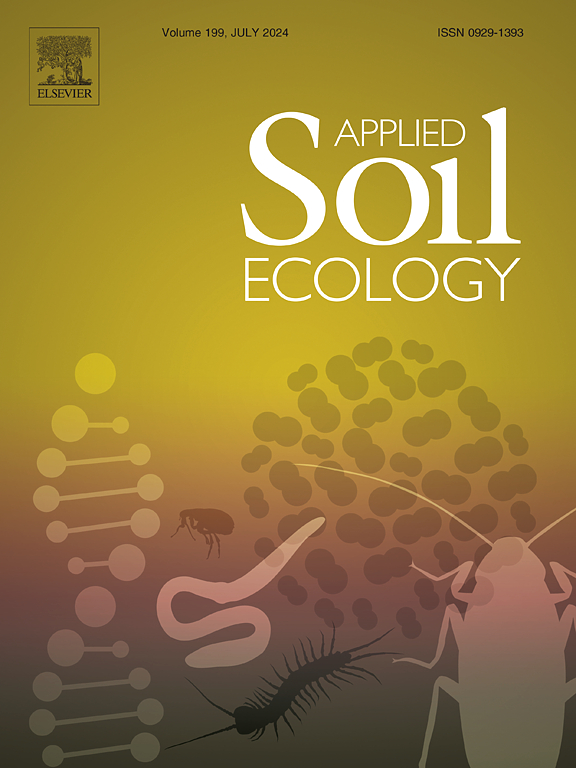欧洲山毛榉林中道格拉斯冷杉和银杉比例增加时土壤中游动物群落的变化
IF 5
2区 农林科学
Q1 SOIL SCIENCE
引用次数: 0
摘要
温带森林受到气候变化引起的温度升高和干旱事件的挑战。为了提高森林的恢复力,混交林林分越来越受到重视。然而,对于不同混合比例如何影响土壤动物群落作为凋落物分解和其他生态系统功能的驱动因素,人们知之甚少。在德国南部欧洲山毛榉(Fagus sylvatica)与非本土道格拉斯杉木(Pseudotsuga menziesii)和本土银杉(Abies alba)两种不同比例针叶树混交林中,研究了主要的土壤中系动物类群,其中甲螨(Oribatida, Acari)和棘螨(Collembola,昆虫目)为营养动物,中系螨(mesostimata, Acari)为捕食动物。甲螨数量最多、种类最多,对森林类型的变化反应敏感,群落组成在种、科水平上均发生变化。道格拉斯-杉木-山毛榉群落中,山毛榉的丰度和多样性均低于银杉-山毛榉群落。中皮螨的丰度最低,但达到中等丰度,对森林混交林的响应不显著。然而,只有在科和种水平上的甲螨物种组成对森林类型的差异有响应,这表明混合山毛榉林中针叶林比例高低对土壤中系动物群落的影响相似,特别是甲螨可以作为种植不同混交林类型的后果的指标。综上所述,在山毛榉混交林中种植非本地针叶树和本地针叶树(如道格拉斯松和银杉)的结果与在纯山毛榉混交林中种植针叶树的结果相似,两者在很大程度上重叠。本文章由计算机程序翻译,如有差异,请以英文原文为准。
Changes in soil mesofauna communities with increasing proportions of Douglas-fir and silver fir in European beech forests
Temperate forests are challenged by increasing temperature and drought events due to climate change. In order to enhance forest resilience, mixed forest stands are increasingly promoted. However, little is known on how different mixture proportions affect soil animal communities as drivers of litter decomposition and other ecosystem functions. We investigated major soil mesofauna groups, including oribatid mites (Oribatida, Acari) and collembolans (Collembola, Insecta) as detritivores and mesostigmatid mites (Mesostigmata, Acari) as predators, in mixed stands of European beech (Fagus sylvatica) with two conifer species of different proportions including non-native Douglas-fir (Pseudotsuga menziesii) and native silver fir (Abies alba) in southern Germany. Oribatid mites were most abundant and diverse, and responded sensitively to changes in forest type with an altered community composition at species- as well as family-level. Collembolans were less abundant and featured lower diversity, which was higher in Douglas-fir - beech compared to silver fir - beech mixtures. Mesostigmatid mites were least abundant, while reaching an intermediate species richness, and did not significantly respond to forest mixtures. However, only species composition of oribatid mites at both family- and species-level responded to differences in forest types pointing to similar effects of low and high conifer proportions in mixed beech stands on soil mesofauna communities, indicating that in particular oribatid mites may serve as indicator for consequences of planting different mixed forest types. Overall, the results indicate that the consequences of planting non-native and native conifers, such as Douglas-fir and silver fir, in mixed stands with beech are similar with the mesofauna community in both overlapping in large with that in pure beech stands.
求助全文
通过发布文献求助,成功后即可免费获取论文全文。
去求助
来源期刊

Applied Soil Ecology
农林科学-土壤科学
CiteScore
9.70
自引率
4.20%
发文量
363
审稿时长
5.3 months
期刊介绍:
Applied Soil Ecology addresses the role of soil organisms and their interactions in relation to: sustainability and productivity, nutrient cycling and other soil processes, the maintenance of soil functions, the impact of human activities on soil ecosystems and bio(techno)logical control of soil-inhabiting pests, diseases and weeds.
 求助内容:
求助内容: 应助结果提醒方式:
应助结果提醒方式:


